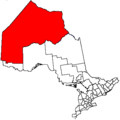This article includes a list of references, related reading, or external links, but its sources remain unclear because it lacks inline citations .(March 2025) |
Naotkamegwanning First Nation, formerly known as Whitefish Bay First Nation and known in the Ojibwe language as Ne-adikamegwaning (Of the Whitefish Point), is an Ojibwe Nation in the Treaty 3 territory, 90.4 km (56 mi) from Kenora, Ontario and is near Sioux Narrows, Ontario of Lake of the Woods.
Contents
The total registered population in September, 2010, was 1177, of which the on-reserve population was 713. The First Nation is a member of the Kenora Chiefs Advisory and part of Grand Council Treaty 3

